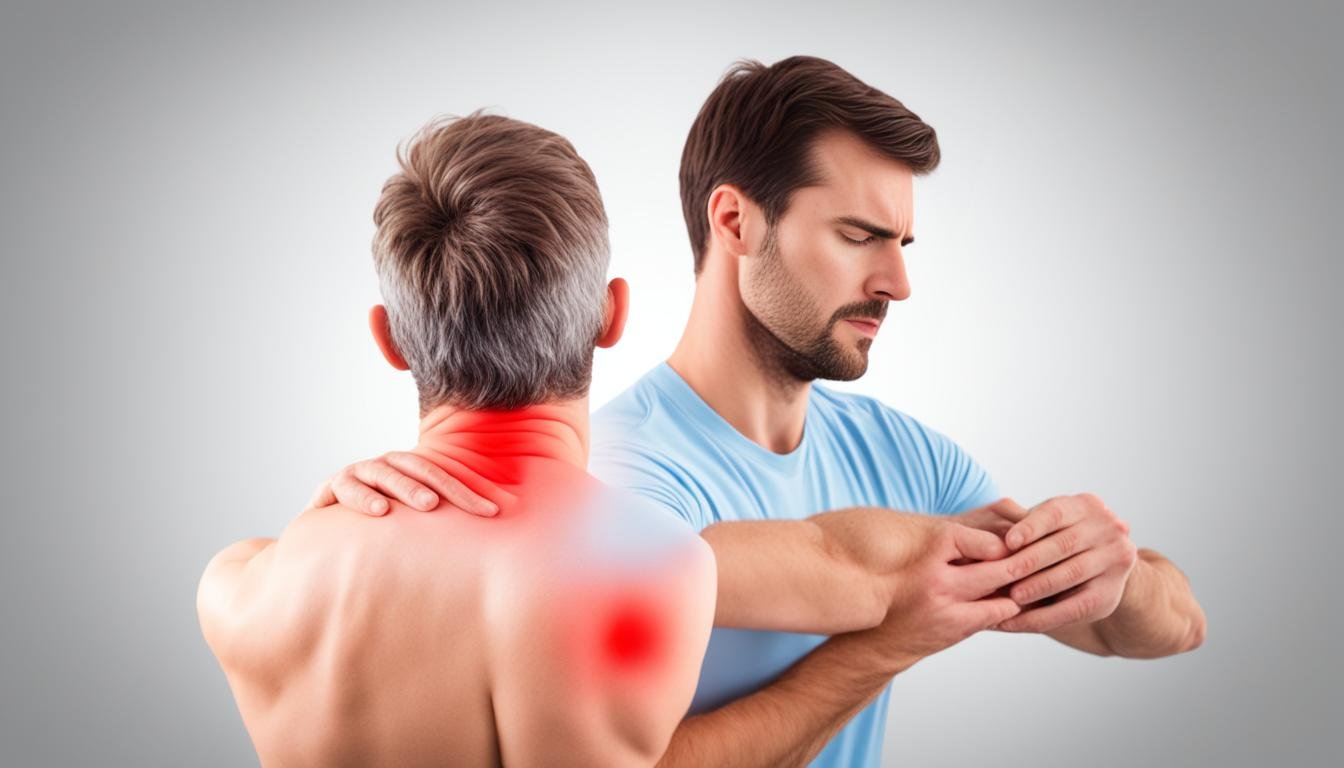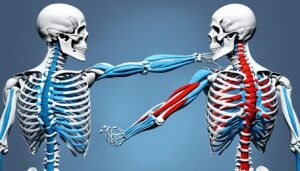Feeling pain in your upper right back? You’re not alone. Many factors can cause this pain, like muscle strain and herniated discs. But you can treat it at home and with a doctor’s help.
Thoracic back pain happens anywhere in your upper back. It’s most common between your shoulder blades. Things like muscle strain and herniated discs can lead to this pain.
Key Takeaways:
- Upper right back pain can range from mild to debilitating, affecting your freedom of movement and daily activities.
- Causes of upper right back pain include muscle strain, overuse, herniated discs, vertebrae fractures, osteoporosis, and osteoarthritis.
- Risk factors for upper back pain include obesity, lack of exercise, age, chronic stress, improper lifting, poor posture, and smoking.
- Symptoms of upper right back pain may include radiating pain, muscle weakness, and numbness.
- Treatment options for upper right back pain include medication, hot and cold therapy, rest, and targeted exercises and stretches.
Understanding Upper Side Back Pain
Feeling pain in your upper right back, known as thoracic back pain, is common. It can show up for many reasons. This back part is key for moving your upper body. Knowing about the upper back helps find what’s causing your pain.
Location of Upper Right Back Pain
This pain starts at your neck’s base and goes down your right rib cage side. It includes the top of your thoracic spine. Any trouble with spine parts, discs, muscles, or nerves can cause upper right back pain.
Anatomy of the Upper Back
Your upper back, or upper back anatomy, is made of bones, joints, and soft tissues. The 12 vertebrae of the thoracic spine support your upper body. Spinal discs between them absorb shocks and help you move smoothly. Muscles, ligaments, and tendons make your upper back and shoulders move.
Knowing your upper back’s anatomy is crucial. It helps you and your doctor find what’s wrong and plan the right treatment.
Causes of Upper Right Back Pain
There are many reasons for upper right back pain. It might be due to muscle strain or can be a sign of something more severe. Knowing the causes can help you stay healthy and pain-free.
Muscle Strain or Injury
Pulling upper back muscles can happen from too much activity, sudden moves, or lifting heavy stuff. This causes pain and makes it hard to move. It’s a common reason for upper right back pain.
Spinal Fractures
Big accidents or falls can lead to spinal fractures. These breaks in the vertebrae can be simple or very serious. They might cause muscle spasms, weakness, or even make you unable to move.
Osteoporosis
Osteoporosis makes bones weak and easy to break. A spinal fracture because of this can cause sudden back pain. It may also make you a bit shorter.
Osteoarthritis
OA can make the spine’s joints hurt and lead to upper back pain on the right side. This might come with other problems like bending of the spine, pain spreading out, weakness, numbness, cramps, or stiffness.
Stress
Feeling a lot of stress can make your back ache. This can cause your muscles to tense and lead to a fast heartbeat, headaches, or a bad stomach.
Referred Pain
Problems with organs near the back can also cause pain that feels like it’s in the upper right back. This includes issues with the gallbladder or lung infections.
Spinal Infection
Infections in the spine by germs like bacteria, viruses, or fungi can bring upper back pain. It might come with numbness, feeling cold, fever, or a tingling sensation.
Herniated Discs
A disc in the spine that bulges can hurt your upper back. This is more common in the lower back but can also affect the neck. It happens a lot in older people or those carrying extra weight.
upper side back pain right side
Pain in the upper right back can be mild or very strong. It can make it hard to move and do your normal activities. Many things can cause this pain. This includes problems with the spine, muscles, and nerves on the upper right part of your back.
Upper side back pain right side and right side upper back pain can be due to several reasons. Such as, muscle strains, broken bones in the spine, and conditions like osteoporosis and arthritis. They might also lead to issues like pain, not being able to move a lot, and muscle spasms.
If you have strong or lasting upper side back pain right side, go see a doctor. They can find out what’s wrong and help you with the right treatment. They might do tests to see what’s causing your pain.
Learning about what might be causing your pain can help you. It can let you take steps to handle it and get better. Then, you can enjoy life without being in too much pain.
Upper Back Pain When Breathing
Sometimes, upper back pain feels worse
Symptoms of Upper Right Back Pain
Do you have pain in the upper right back? It may feel sore under or close to the shoulder blade. A common cause is a strain in the rhomboid muscles.
This pain can also spread to the neck, arms, or shoulders. Such pain might point to a more serious issue like a herniated disc or osteoarthritis.
You might feel muscle weakness or numbness too. These signs could mean a bigger problem, like a spinal fracture or spinal infection.
Treatment for Upper Right Back Pain
Most of the time, you can handle upper right back pain at home. You can take over-the-counter meds like ibuprofen to help with the pain. Heat treatments, like using a hot water bottle, and warm baths can make your muscles feel better.
Ice packs work well for sudden pain and swelling. They can cool down the area and ease your discomfort.
Medication
Nonsteroidal anti-inflammatory drugs, short for NSAIDs, work for upper back pain. They fight swelling and make you feel better. Medicines you can buy without a prescription, like ibuprofen, are often the top pick for treating upper back pain.
Hot and Cold Therapy
Heat and cold can be easy and useful for upper back pain. A heating pad or a warm bath can relax the muscles and boost blood flow. But, ice packs can cut down on swelling and pain, giving quick relief.
Rest
Rest is key for healing your upper right back pain. Cut down on sitting still and stop doing things that make it worse. But, don’t stay completely still. Moving a bit can stop your back from getting too stiff.
Stretches and Exercises
Doing gentle stretches and exercises can stop and ease upper back pain. Things like yoga, stretching your shoulders, and moving your back while sitting, can really help. Adding these to your daily routine can boost your back’s strength and flexibility.
Prevention Tips
You can try to lower your risk of upper back pain. Use proper lifting techniques. Keep your back straight and lift with your legs. This can stop you from getting hurt. Take regular breaks from sitting a lot. Make sure you keep good posture when you stand or sit.
Warming up before you work out is good to avoid back pain too. Make sure to stop if something hurts your back. Including these in your daily life can help you stay pain-free.
Proper Lifting Techniques
When lifting heavy stuff, use the right form. Keep your back straight and lift with your legs. This way, you don’t hurt your upper back.
Taking Breaks from Sitting
Staying seated too long can stress your upper back. Take short breaks to stand up and stretch. It helps your posture and lowers your pain risk.
Good Posture
Good posture is key to avoid upper back pain. Sit and stand with your shoulders back and head straight. Don’t slouch. It stops your back muscles from getting hurt.
Warming Up Before Exercise
Always warm up before moving a lot. Warm-ups can be easy stretches, light cardio, or active exercises. This readies your body and helps avoid pain.
When to Seek Medical Attention
If your upper right back hurts, at-home treatment might work within a week. But you need to see a doctor if the pain is severe. Also, if it sticks around for more than a week or if you feel muscle weakness or numbness. Even tingling, fever, or problems with the bathroom might signal something serious. If an injury causes your back pain, it’s time for a doctor visit. This is key to finding and treating the real issue behind your upper right back pain.
Does your upper back pain keep getting worse or doesn’t go away? Talking to a healthcare pro is vital. They’ll check things closely, run some tests, and pinpoint what’s causing your pain. Knowing this can lead to the right care. It also stops the problem from getting worse.
If your upper right back pain is really bad or comes with odd symptoms, don’t wait. A fast checkup and treatment mean less suffering later. So, get help soon.
Risk Factors for Upper Back Pain
Several things can make you more likely to have upper back pain. Being too heavy can push down on the back, causing pain. Not exercising leads to weak back and tummy muscles, upping the chance for pain. And, as people get older, they tend to have more upper back issues. This starts happening when they reach about 30 or 40 years old.
Obesity
If you carry too much weight, your back muscles work harder and hurt more. The extra pounds press on the spine, causing pain and other back problems.
Lack of Exercise
Skipping exercise makes your back and core muscles weaker. This makes your upper back more prone to hurt. Doing light aerobics and exercises for your belly and back can make these muscles stronger. This support helps with pain.
Age
Back pain, including in the upper back, is more common as you get older. From about 30 or 40 years old, the risk goes up. Reasons include spine changes and weaker muscles.
Chronic Stress
Feeling stressed or anxious can lead to upper back pain. Long-term stress makes your muscles tight and sore in the upper back.
Smoking
Smoking can also bring on upper back pain. People who smoke tend to have more back pain. It’s because smoking cuts down on blood flow to the spine and slows down healing.
Working on these risk factors can make a big difference. Keeping a good weight, staying active, and dealing with stress help a lot. Quitting smoking is also a good idea. These steps can stop or reduce upper back pain.
Diagnosis and Imaging Tests
Doctors first ask if you’ve had any injuries that could explain the pain. They will also look at your past health and what symptoms you have now. Then, they might order tests that show pictures of your spine and nearby areas.
Here are some tests they might do for upper back pain:
- X-rays – X-rays find bone issues like fractures or arthritis. But they can’t see problems in the spinal cord, muscles, nerves, or discs.
- MRI (Magnetic Resonance Imaging) – MRIs give very detailed images. They can find conditions like herniated discs, nerve issues, and soft tissue problems.
- CT (Computed Tomography) Scans – CT scans are good for finding issues in the spinal canal and around the spine.
- Blood Tests – Blood tests check for infections or other health problems that might be causing your back pain.
- Nerve Studies (EMG) – EMGs test to see if there’s nerve pressure from problems like herniated discs or spinal stenosis, which could be causing your pain.
Your doctor will use a mix of these tests to find out the reason for your pain. This helps make a plan to treat it.
Conclusion
Upper right back pain has many causes. It could be from muscle strain, spinal issues, or arthritis. It might even come from other health problems.
Most of the time, you can treat this pain at home. But, if the pain doesn’t go away or gets worse, you might need a doctor’s help. It’s important to know what can cause the pain and how to treat it. This way, you can handle this common type of back pain.
Good posture and being active can help lower your chances of getting this kind of back pain. If the pain keeps coming back or gets worse, see a doctor. They can find out why you are hurting and help you feel better. This will help you prevent more pain in the future.
It’s key to deal with this pain early and in the right way. Doing this is essential for staying healthy and enjoying life. By acting quickly and getting the help you need, you can beat this back problem. Then, you can go on with your normal activities without worry.




